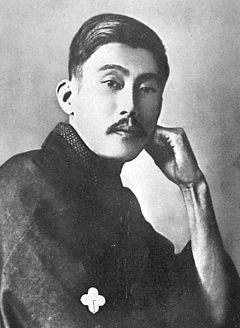- Ozaki Kōyō
-
Ozaki Kōyō
尾崎 紅葉
Ozaki KōyōBorn 10 January 1868
Edo JapanDied October 30, 1903 (aged 35)
Tokyo JapanOccupation Writer Genres novels, poetry Ozaki Kōyō (尾崎 紅葉, January 10, 1868 - October 30, 1903) was a Japanese author. His real name was Ozaki Tokutarō (尾崎 徳太郎).
Biography
Ozaki was the only son of Kokusai (尾崎 谷斎), a well-known netsuke carver in the Meiji period. He was educated at Tokyo Prefecture Middle School, and later Tokyo Imperial University. At university, he started publishing a literary magazine called 'Ken'yūsha' (Friend of the ink stone) in 1885 with his friends. Yamada Bimyo and Kawakami Bizan also had material published in the magazine.
Ozaki's most renowned works were The Usurer (金色夜叉 Konjiki Yasha) (also known as The Golden Demon, which first appeared in 1887 in the Hakubunkan magazine Nihon Taika Ronshū (日本大家論集, lit. Japan Expert Treatise Collection)) and Tajo Takon. His works mostly appeared in the Yomiuri Shimbun, the most popular newspaper in Japan. His pupil Izumi Kyōka continued to write in Ozaki's style.
See also
- Japanese literature
- List of Japanese authors
External links
Categories:- 1868 births
- 1903 deaths
- Japanese novelists
- Japanese poets
- Japanese writers
- People from Tokyo
- Japanese writer stubs
Wikimedia Foundation. 2010.
